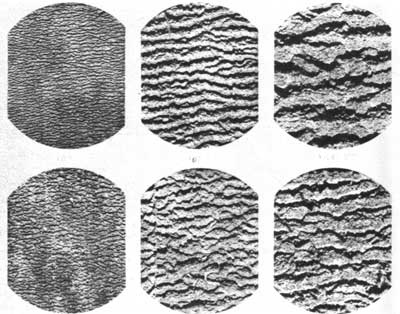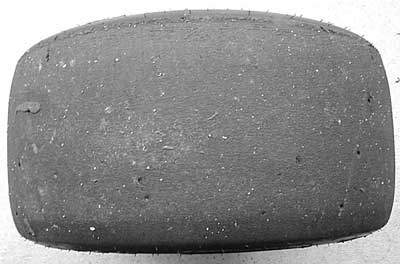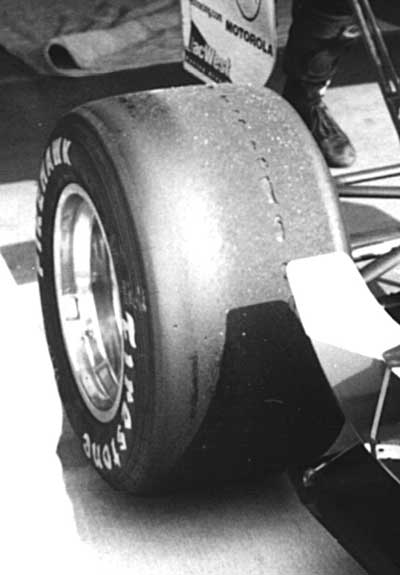INSIDE
RACING
T E C H N O L O G Y
IRT Home
IRT Home
Contents Page
email Paul
This excerpt is from Chapter 8 of The Racing & High-Performance Tire. It appeared in the March 2004 issue of Sports Car magazine.
The Real World, Using Tires
People who are actually using tires-serious road racers, circle-track racers, and autocrossers-have learned a lot about tires by trial and error. Hopefully these excerpts from The Racing & High-Performance Tire offer up some whys that will generate more knowledge among these racers and make them more confident when they're using their tires at the limit. Lower lap times forever!
Tire Give-Up
A racecar uses a set of tires a length of time, termed a tire stint, mainly determined by the number of laps required to use the fuel allowed by the rules. In most race series it takes more time to refuel the car than it does to change tires, so no time is saved by refueling only. In professional racing there is no reason for the tires to have a useful life that is any longer than a fuel stint.
For most tires the first lap or two are the fastest laps those tires will ever produce. Recently Michelin returned to Formula 1 to compete with Bridgestone in a good old-fashioned tire war. Some Michelin F1 tires appear to increase in performance after five to seven laps and reach peak grip during laps 10-20 before falling off slightly.
The Goodyear tires sold to NASCAR Winston Cup teams these days "give up" at least a second in lap time from the second through the tenth lap and continue to deteriorate until the end of the stint. In fact you can see the tires give up during the two-lap qualifying runs for the Winston [now Nextel] Cup races. The first lap is almost always the quickest and many drivers just run one lap and go back into the paddock. The amount of give-up from the first to the second lap is 0.05 to 0.1 seconds per mile of lap.
So why do tires give up? The reason is similar to that described in the section on tire scrubbing. The rubber in tires, especially tread rubber, undergoes cyclic stress at very high levels. The work done by these rubbers result in heat generation. The combination of high cyclic stress and high temperature is bound to generate mechanical and chemical changes in the rubber.
Some elastomers, and rubber falls into that category, exhibit stress softening and permanent set. Stress softening has been attributed to displacement of polymer network junctions and entanglements and/or the incomplete recovery to original positions of those junctions and entanglements after stress deformation. The presence of fillers [carbon black and silica] introduces possible additional softening mechanisms, including breakage of rubber/filler attachments, disruption of filler structure, or chain slippage at filler surfaces. When intermolecular structures are irreversibly disrupted or reform in new positions while the polymer is extended, the result is permanent deformation. The rubber is said to have "taken a set."
A rubber compound is a mix of many materials, including chemically active agents. An excess of certain kinds of active agents can provide an opportunity for a disrupted or broken bond to repair itself by rebonding at the same location or in a new location.
Another mechanism for tire give-up is more simple. The tire might wear to a tread thickness too thin to generate enough heat and the tire temperature falls out of the range for max grip. A thick tread, even a slick, deforms and the resulting hysteresis generates heat. A thin tread deforms less, generating less heat.
Heat Cycles
Rubber is a complex substance, a mixture of materials and chemicals manufactured with mechanical processes and various heat and pressure cycles. In use, tread rubber sees mechanical working and time at elevated temperatures very similar to the processes it saw as it was manufactured. It makes sense that more of the same processing would further change the rubber.
The material in a new race tire is semi-stable. If the tread rubber had been totally cured it might be too hard to do its job. So stress and heat can continue the curing process. Even small amounts of energy from ultraviolet wavelengths in sunlight, ozone in air, heat, or mechanical working can cause the rubber in a tire to continue its vulcanization process or change in some way.
The first heat cycle is called scrubbing and was described earlier. Every heat cycle changes a tire to some degree, generally in the direction of harder, less flexible, and less adhesive. Race tires can loose effectiveness before the tread wears through if they go through many heat cycles. For some tires three cycles is too many, while others show a performance drop off initially and then maintain a good level of performance until the tread is worn off. Smart race organizers are incorporating long-lasting tires into their rules so that "spec" tires can lower the cost of racing. Some racers attempt to enhance the performance of used tires with additives and treatments as described later in this chapter.
Abrasion and Graining
The abrasion patterns shown in the photos in Fig. 8.6 were produced by abrading two different rubber samples on different road surfaces. The abrasion profiles compare natural rubber abraded on silicon carbide cloth (the top row of photos) with a worn tire (the bottom row).

What you see here is called graining. The cause, typically, is overly aggressive driving with a tire that is too soft and grippy for the conditions or the driver has overworked the tires before getting them up to a working temperature. Abrasion patterns are not necessarily caused by gross sliding. A requirement for the development of an abrasion pattern is "unidirectional sliding." Sliding in random directions does not produce these patterns. The orientation of the pattern is important because it indicates the direction of relative motion between the tread and the road.
Here's how that pattern gets worked into the rubber. When a new rubber sample is continuously abraded in the same direction, the rubber develops an array of nearly parallel ridges at right angles to the abrasion direction. The shape of the ridges in cross section, seen in Fig. 8.7, is saw toothed, with the teeth pointed against the direction of abrasion. During sliding, deflection waves in the rubber turn into peaks which are bent over, exposing the upstream side to abrasion. The peaks wear thinner into teeth and the tips are eventually torn off.

Sliding on smooth tracks does not always produce abrasion. Abrasion is generally initiated by local stress concentrations at the contact between track asperities and rubber. Abrasion intensity depends on shape rather than size of the asperities. Experiments have shown that road surfaces exhibit wide variations in abrasion characteristics.
Lab experiments with abrasion in an inert atmosphere-nitrogen-show less abrasion than the same process in air. This leads to speculations that antioxidants in a rubber compound can make it more resistant to abrasion.
Unfortunately, once a graining pattern is worn into the surface of a tire it's difficult to wear the pattern away. The ridges tend to perpetuate as wear continues. Even worse, since the tread is not evenly loaded after it has been grained, the tire loses grip. It's just another way for a driver to mess up. That's why experienced drivers are so valuable.
Graining on Pavement

These photos, taken by Ted James, show graining on tires used in club racing on a pavement road course. The tire in Fig. 8.15 shows a front tire with even wear, no graining.
The next image, Fig. 8.16, is a rear tire with graining on the inside edge, perhaps due to excessive camber. The graining is not present across the entire tread, suggesting slippage during acceleration. More camber would create more graining and the pattern would appear over a wider area of the tread.

Blistering
In the chapter on compounding we described the vulcanization process and mentioned that if the process goes too far, the rubber can "revert" or return to its uncured state. Reversion can also happen when race tires get way too hot. When you see a driver lock up a tire the smoke tells you something bad is happening. The resulting flat spot is caused by frictional heating of the tread rubber causing reversion. The overheated rubber softens and is scrubbed off the tire.
Another, less severe, form of reversion is blistering. The photo in Fig. 8.17 shows a right-rear tire with a line of blisters around its circumference. Too high cold inflation pressure or too much pressure build-up during use caused the tread to overheat. The heat is generated at the interface between the belt plies and the tread and the rubber melts, causing a local blister.

Mark Blundell won the Fontana CART race in 1997 for the PacWest team but he barely dodged the blister bullet. It was a very fast race on a very hot day. The Firestone guys saw the problem after early pit stops and told the teams to use lower cold pressures that would decrease loading in the middle of the contact patch. But a few teams still had problems.
Some tire companies have developed anti-reversion compounds that resist blistering. That's all I know about it because of course they won't talk about it. And I can see why this would work. If you can run your tire a little bit hotter without blistering that would be more forgiving for the racers using the tire and maybe the tire would give a little more grip at the higher temperature. That's assuming the anti-reversion compound has no negative trade-offs.
If you learned from this excerpt, you should buy the book!